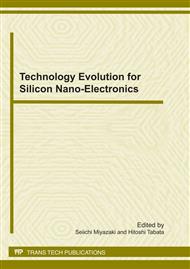p.48
p.54
p.60
p.66
p.72
p.79
p.85
p.92
p.98
Novel Source Heterojunction Structures with Relaxed-/Strained-Layers for Quasi-Ballistic CMOS Transistors
Abstract:
We have studied new abrupt-source-relaxed/strained semiconductor-heterojunction structures for quasi-ballistic complementary-metal-oxide-semiconductor (CMOS) devices, by locally controlling the strain of a single strained semiconductor. Appling O+ ion implantation recoil energy to the strained semiconductor/buried oxide interface, Raman analysis of the strained layers indicates that we have successfully relaxed both strained-Si-on-insulator (SSOI) substrates for n-MOS and SiGe-on-insulator (SGOI) substrates for p-MOS without poly crystallizing the semiconductor layers, by optimizing O+ ion implantation conditions. As a result, it is considered that the source conduction and valence band offsets EC and EV can be realized by the energy difference in the source Si/channel-strained Si and the source-relaxed SiGe/channel-strained SiGe layers, respectively. The device simulator, considering the tunneling effects at the source heterojunction, shows that the transconductance of sub-10 nm source heterojunction MOS transistors (SHOT) continues to increase with increasing EC. Therefore, SHOT structures with the novel source heterojunction are very promising for future quasi-ballistic CMOS devices.
Info:
Periodical:
Pages:
72-78
Citation:
Online since:
February 2011
Authors:
Keywords:
Price:
Сopyright:
© 2011 Trans Tech Publications Ltd. All Rights Reserved
Share:
Citation:


